Evaluation of the Time of Concentration Models for Enhanced Peak Flood Estimation in Arid Regions
Abstract
1. Introduction
2. Materials and Methods
3. Results and Discussion
3.1. Evaluation of Model Performance
3.2. Development of a New Model for the Saudi Arid Environment
3.3. Probability Distribution and Hypothesis Testing
4. Conclusions
- The Dooge model shows the highest correlation with observed Tc at an r equal to 0.60, while the Izzard and Hicks model shows the least correlation at an r equal to −0.15.
- With regard to the predictive capability, the Jung model shows the best predictive efficiency, with Nash–Sutcliffe efficiency and normalized Nash–Sutcliffe efficiency values of 0.33 and 0.60, respectively, while USGS shows the poorest predictive efficiency, with Nash–Sutcliffe efficiency and normalized Nash–Sutcliffe efficiency values of −550.12 and 0.00, respectively.
- Based on the mean error and root mean square error, the Jung model produced the least mean error of −0.10 h, while USGS resulted in the largest mean error of 120.77 h. Similarly, the Jung model produced the least root mean square error of 4.72 h, while USGS produced the largest root mean square error of 1643 h.
- According to the relative bias, the highest underestimation is observed with the Albishi et al. (2017) [19] model at −77%, the least underestimation with the Jung model at −1%, the highest overestimation with USGS at 1643%, and the least overestimation with Kirpich at 4%.
- It is observed that 80% of all the models evaluated overestimated observed Tc, while the remaining 20% underestimated observed Tc in arid regions.
- The new Tc model developed from data in arid environments performed better than the models evaluated, with a correlation coefficient of 0.62, mean error of 0.07 h, root mean square error of 4.53 h, relative bias of 0.9%, as well as Nash–Sutcliffe efficiency of 0.38 and normalized Nash–Sutcliffe efficiency of 0.62. This proposed model is recommended to be used in flood studies in the Saudi arid environment.
- Hypothesis testing revealed that log-normal, Gamma, and Beta distributions are a good fit for the Tc data in arid regions at a 5% significance level.
- The AIC test, which was applied to demonstrate the best probability distribution, shows that log-normal provides the best fit for the observed Tc data at a 5% significance level.
Author Contributions
Funding
Institutional Review Board Statement
Informed Consent Statement
Data Availability Statement
Acknowledgments
Conflicts of Interest
References
- Kirpich, Z.P. Time of Concentration of Small Agricultural Watersheds. Civ. Eng. 1940, 10, 362. [Google Scholar]
- Fang, X.; Cleveland, T.; Garcia, C.A.; Thompson, D.; Malla, R. Literature Review on Timing Parameters for Hydrographs; Department of Civil Engineering, Lamar University: Beaumont, TX, USA, 2005. [Google Scholar]
- Johnstone, D.; Cross, W.P. Elements of Applied Hydrology; Ronald Press: New York, NY, USA, 1949. [Google Scholar]
- Nagy, E.D.; Torma, P.; Bene, K. Comparing Methods for Computing the Time of Concentration in a Medium-Sized Hungarian Catchment. Slovak J. Civ. Eng. 2016, 24, 8. [Google Scholar] [CrossRef]
- Kaufmann de Almeida, I.; Kaufmann Almeida, A.; Garcia Gabas, S.; Alves Sobrinho, T. Performance of Methods for Estimating the Time of Concentration in a Watershed of a Tropical Region. Hydrol. Sci. J. 2017, 62, 2406–2414. [Google Scholar] [CrossRef]
- Bengtson, H. Rational Method Hydrologic Calculations with Excel; Continuing Education and Development, Inc.: Woodcliff Lake, NJ, USA, 2011; Volume 942, Available online: https://www.cedengineering.com/userfiles/Rational%20Method%20with%20Excel-R1.pdf (accessed on 11 December 2022).
- Hadadin, N. Evaluation of Several Techniques for Estimating Stormwater Runoff in Arid Watersheds. Environ. Earth Sci. 2013, 69, 1773–1782. [Google Scholar] [CrossRef]
- Michailidi, E.M.; Antoniadi, S.; Koukouvinos, A.; Bacchi, B.; Efstratiadis, A. Timing the Time of Concentration: Shedding Light on a Paradox. Hydrol. Sci. J. 2018, 63, 721–740. [Google Scholar] [CrossRef]
- Saini, A.; Sahu, N.; Kumar, P.; Nayak, S.; Duan, W.; Avtar, R.; Behera, S. Advanced Rainfall Trend Analysis of 117 Years over West Coast Plain and Hill Agro-Climatic Region of India. Atmosphere 2020, 11, 1225. [Google Scholar] [CrossRef]
- Sahu, N.; Panda, A.; Nayak, S.; Saini, A.; Mishra, M.; Sayama, T.; Sahu, L.; Duan, W.; Avtar, R.; Behera, S. Impact of Indo-Pacific Climate Variability on High Streamflow Events in Mahanadi River Basin, India. Water 2020, 12, 1952. [Google Scholar] [CrossRef]
- McEnroe, B.M.; Young, C.B.; Gamarra Zapata, R.A. Estimation of Watershed Lag Times and Times of Concentration for the Kansas City Area; Bureau of Research, Department of Transportation: Kansas, KS, USA, 2016. [Google Scholar]
- Yoo, C.; Lee, J.; Cho, E. Theoretical Evaluation of Concentration Time and Storage Coefficient with Their Application to Major Dam Basins in Korea. Water Supply 2019, 19, 644–652. [Google Scholar] [CrossRef]
- Jung, K.; Marpu, P.R.; Ouarda, T.B. Impact of River Network Type on the Time of Concentration. Arab. J. Geosci. 2017, 10, 546. [Google Scholar] [CrossRef]
- Perdikaris, J.; Gharabaghi, B.; Rudra, R. Reference Time of Concentration Estimation for Ungauged Catchments. Earth Sci. Res. 2018, 7, 58–73. [Google Scholar] [CrossRef]
- Fang, X.; Thompson, D.B.; Cleveland, T.G.; Pradhan, P.; Malla, R. Time of Concentration Estimated Using Watershed Parameters Determined by Automated and Manual Methods. J. Irrig. Drain. Eng. 2008, 134, 202–211. [Google Scholar] [CrossRef]
- González-Álvarez, Á.; Molina-Pérez, J.; Meza-Zúñiga, B.; Viloria-Marimón, O.M.; Tesfagiorgis, K.; Mouthón-Bello, J.A. Assessing the Performance of Different Time of Concentration Equations in Urban Ungauged Watersheds: Case Study of Cartagena de Indias, Colombia. Hydrology 2020, 7, 47. [Google Scholar] [CrossRef]
- Gericke, O.J.; Smithers, J.C. Review of Methods Used to Estimate Catchment Response Time for the Purpose of Peak Discharge Estimation. Hydrol. Sci. J. 2014, 59, 1935–1971. [Google Scholar] [CrossRef]
- Wheater, H.S.; Laurentis, P.; Hamilton, G.S. Design Rainfall Characteristics for South-West Saudi Arabia. Proc. Inst. Civ. Eng. 1989, 87, 517–538. [Google Scholar] [CrossRef]
- Albishi, M.; Bahrawi, J.; Elfeki, A. Empirical Equations for Flood Analysis in Arid Zones: The Ari-Zo Model. Arab. J. Geosci. 2017, 10, 51. [Google Scholar]
- USDA. National Engineering Handbook, Section 4: Hydrology; USDA: Washington, DC, USA, 1972.
- de Almeida, I.K.; Almeida, A.K.; Anache, J.A.A.; Steffen, J.L.; Sobrinho, T.A. Estimation on Time of Concentration of Overland Flow in Watersheds: A Review. Geosci. Geociências 2014, 33, 661–671. [Google Scholar]
- Azizian, A. Uncertainty Analysis of Time of Concentration Equations Based on First-Order-Analysis (FOA) Method. Am. J. Eng. Appl. Sci. 2018, 11, 327–341. [Google Scholar] [CrossRef]
- Zolghadr, M.; Rafiee, M.R.; Esmaeilmanesh, F.; Fathi, A.; Tripathi, R.P.; Rathnayake, U.; Gunakala, S.R.; Azamathulla, H.M. Computation of Time of Concentration Based on Two-Dimensional Hydraulic Simulation. Water 2022, 14, 3155. [Google Scholar] [CrossRef]
- Dooge, J.C.I. Synthetic Unit Hydrographs Based on Triangular Inflow. Ph.D. Thesis, Iowa State University, Ames, IA, USA, 1956; 103p. [Google Scholar]
- Clark, C.O. Storage and the Unit Hydrograph. Trans. Am. Soc. Civ. Eng. 1945, 110, 1419–1446. [Google Scholar] [CrossRef]
- Nejadhashemi, A.P.; Sheridan, J.M.; Shirmohammadi, A.; Montas, H.J. Hydrograph Separation by Incorporating Climatological Factors: Application to Small Experimental Watersheds 1. JAWRA J. Am. Water Resour. Assoc. 2007, 43, 744–756. [Google Scholar] [CrossRef]
- Farran, M.M.H. Statistical Analysis of SCS-CN Curve Number for Improved Estimation of Flash Floods in Arid Regions: Case Study in the Southwest of Saudi Arabia. Master’s Thesis, King Abdulaziz University, Jeddah, Saudi Arabia, 2020. [Google Scholar]
- Kolmogorov, A. Sulla Determinazione Empirica Di Una Lgge Di Distribuzione. Inst. Ital. Attuari Giorn. 1933, 4, 83–91. [Google Scholar]
- Smirnov, N.V. Estimate of Deviation between Empirical Distribution Functions in Two Independent Samples. Bull. Mosc. Univ. 1939, 2, 3–16. [Google Scholar]
- Laio, F.; Di Baldassarre, G.; Montanari, A. Model Selection Techniques for the Frequency Analysis of Hydrological Extremes. Water Resour. Res. 2009, 45, W07416. [Google Scholar] [CrossRef]
- Kite, G.W. Frequency and Risk Analysis in Hydrology; Water Resources: Fort Collins, CO, USA, 1978. [Google Scholar]
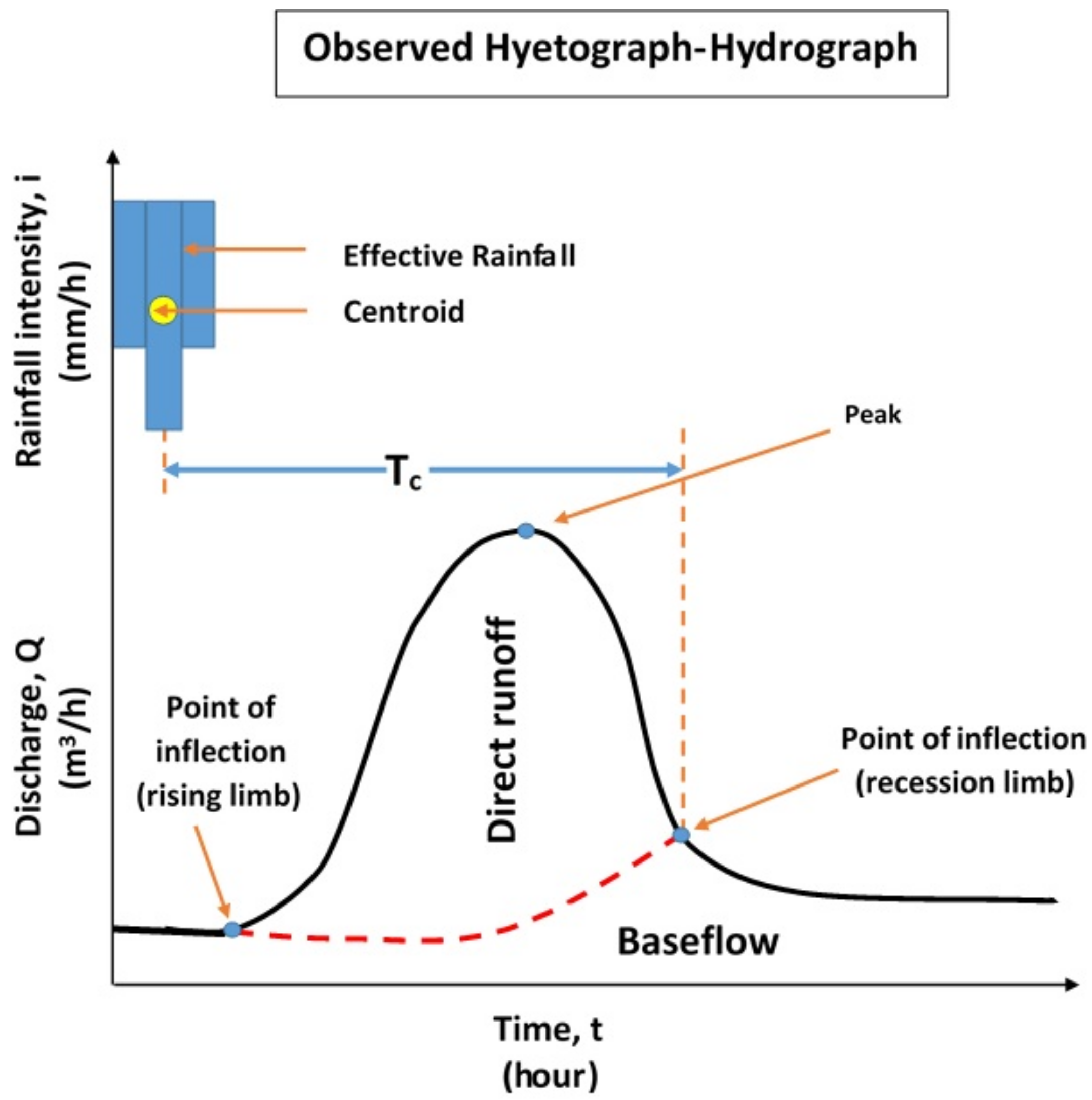
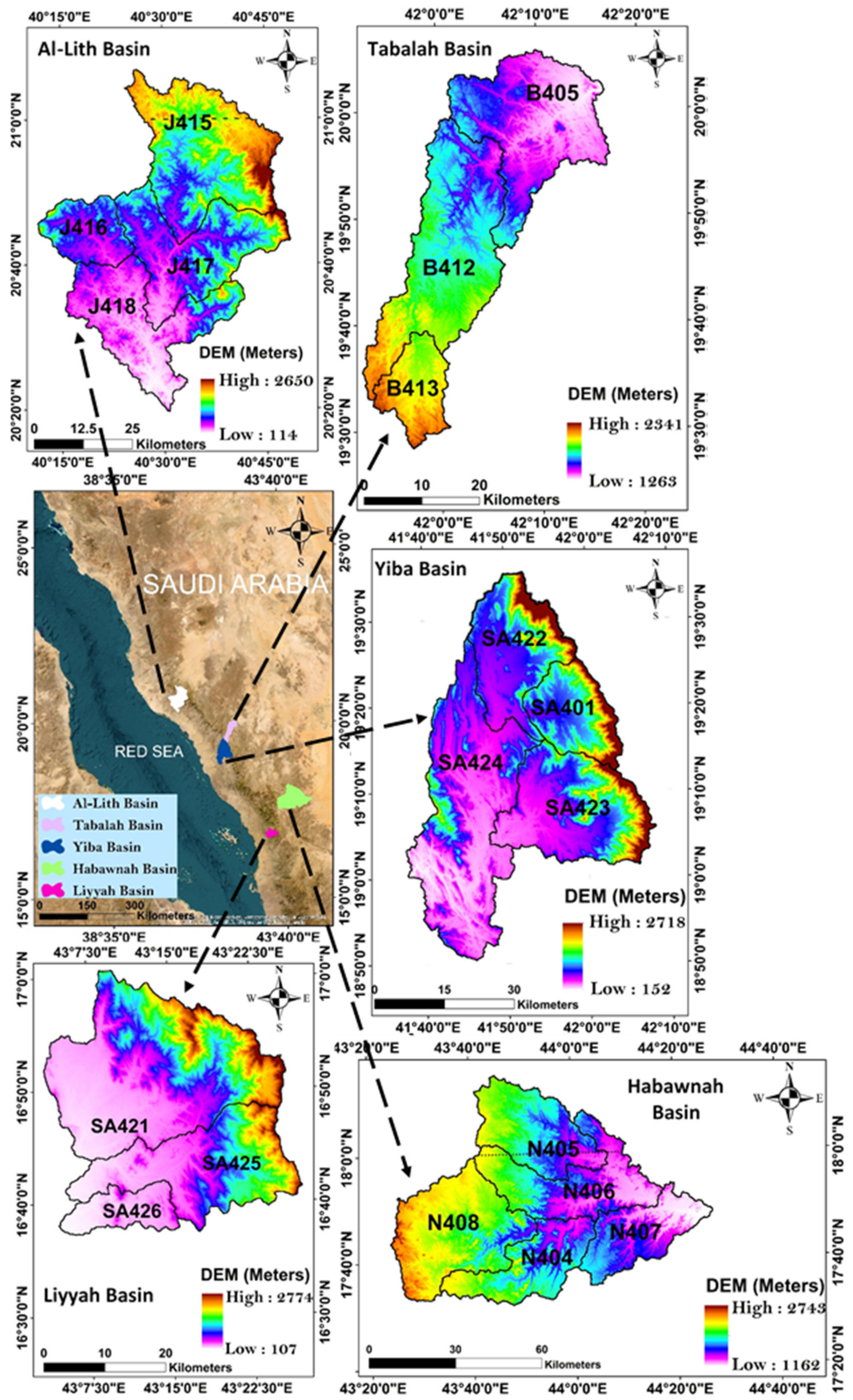

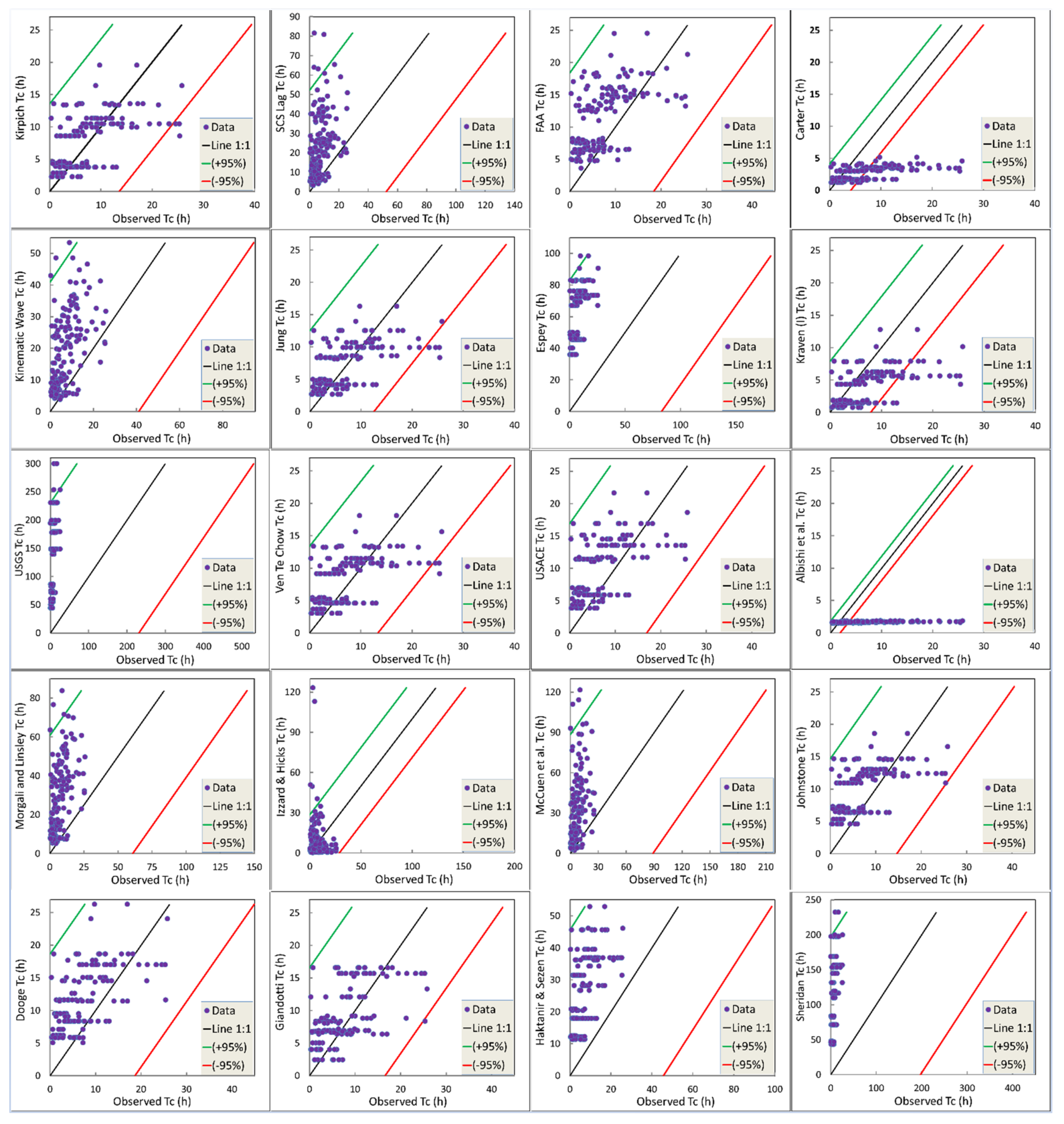
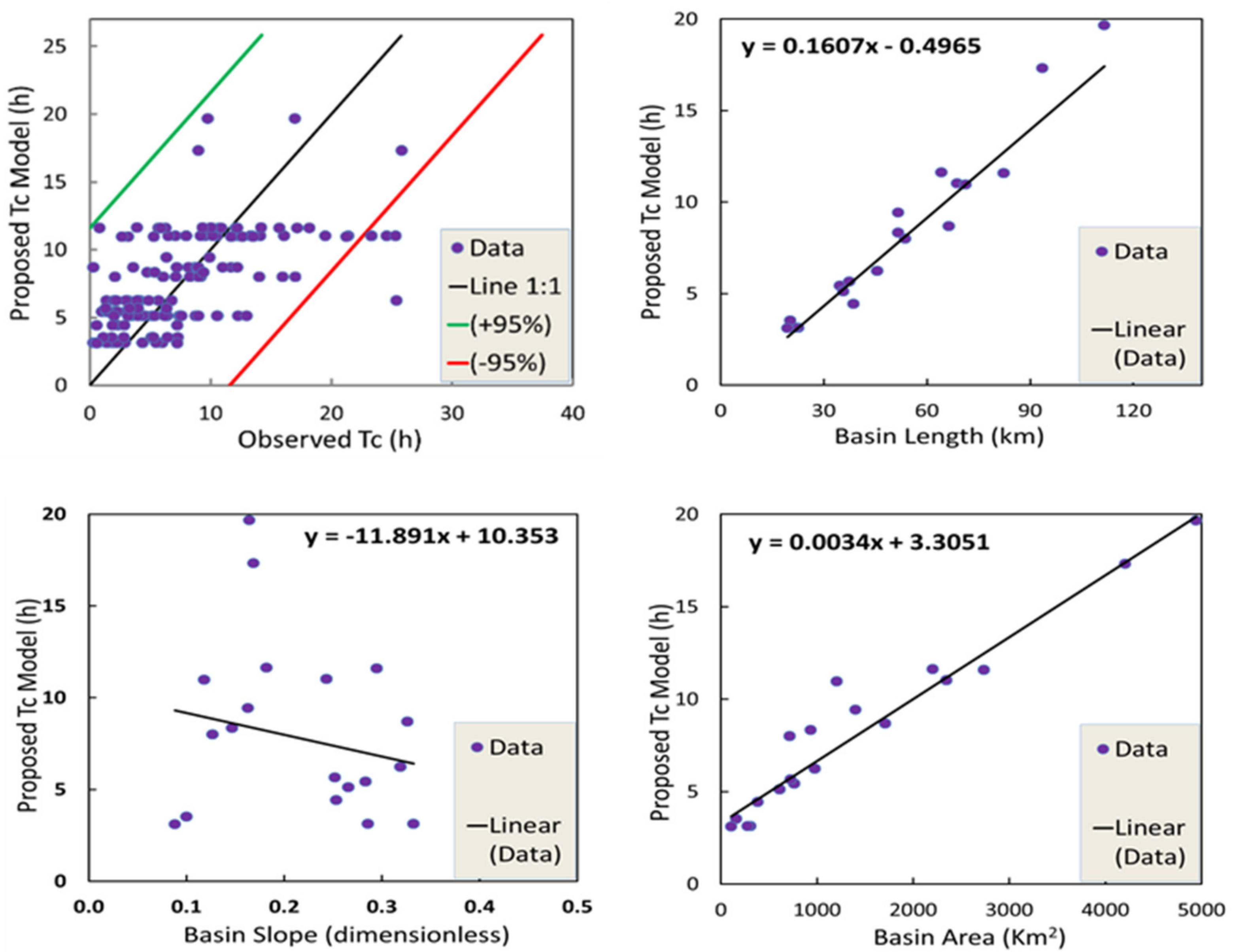
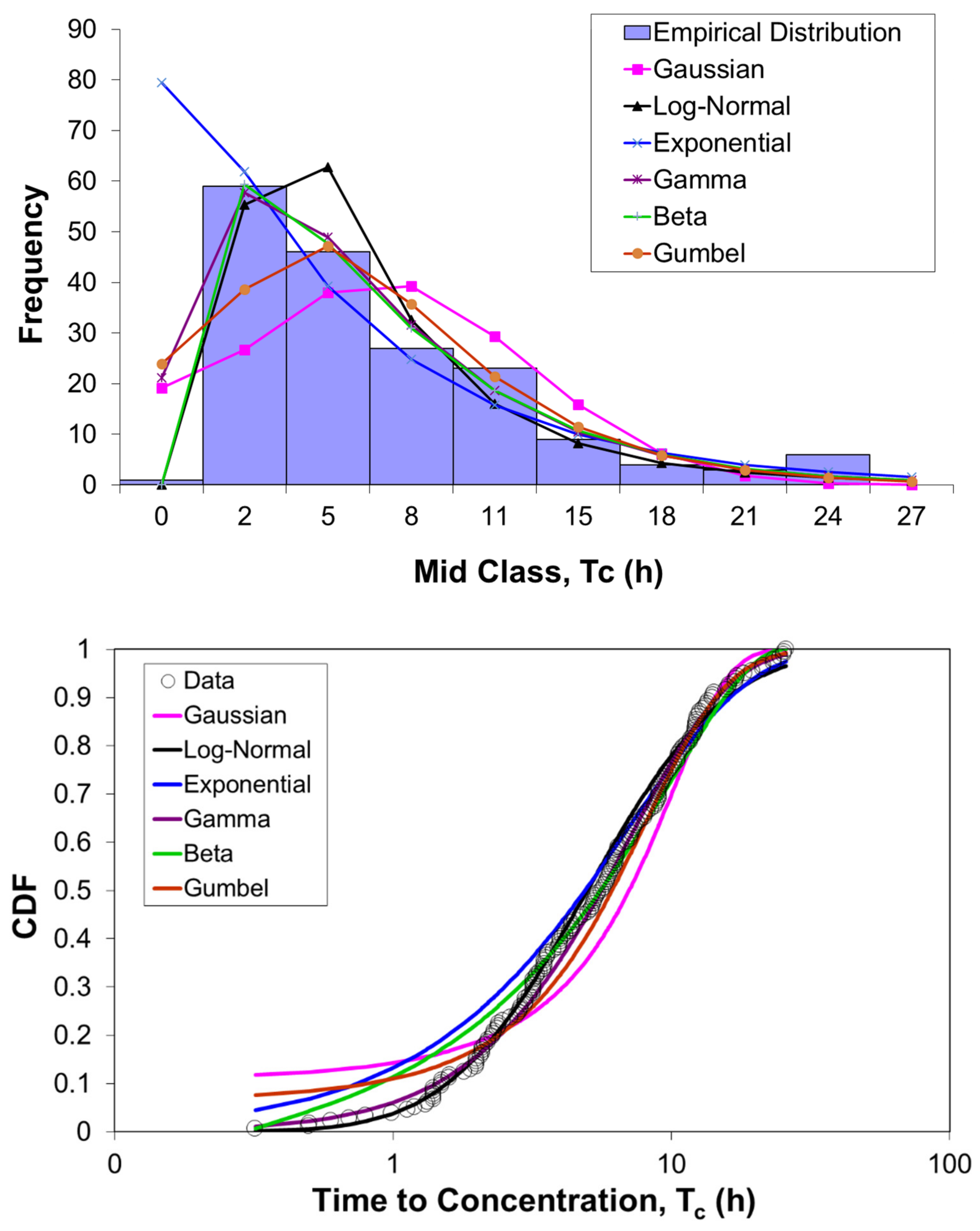
| Parameter | Definition | Range |
|---|---|---|
| Basin Area, A (km2) | - | 107–4.944 |
| Basin Slope, Sb (m/m) | The average slope of the entire basin | 0.09–0.33 |
| Basin length, Lb (km) | Length in a straight line from the mouth of a stream to the farthest point on the drainage divide of its basin | 19–112 |
| Basin elevation, Hm (m) | Difference between the elevation of the highest basin divide and the elevation at the basin outlet | 234.72–2143.95 |
| Flow length, L (km) | Downslope distance from the hydraulically most distant point to the outlet point | 26–158 |
| Flow length slope, S (m/m) | Mean steepness, i.e., the ratio between the mean fall and the L length of the basin’s hydraulically most distant points | 0.01–0.08 |
| Average rainfall intensity, i (mm/h) | - | 0.19–41.13 |
| Roughness coefficient, n | - | 0.04 |
| Curve number, CN | - | 44–98 |
| Runoff coefficient, C | - | 0.0014–0.3724 |
| S/N | Model | Equation for Tc | Definition of Parameters |
|---|---|---|---|
| 1 | Kirpich (1940) [1] | Tc (h) = time of concentration; L (km) = main water line length; and S (m/m) = mean channel slope | |
| 2 | Soil Conservation Service Lag (1972) [20] | Tc (h) = time of concentration; CN: SCS curve number; L (km) = flow path length; S (m/m) = mean slope of channel | |
| 3 | Federal Aviation Administration (1970) [21] | Tc (h) = time of concentration; C: runoff coefficient; L (km) = length of flow path; S (m/m) = mean channel slope | |
| 4 | Carter (1961) [21] | Tc (h) = concentration time; L (km) = main water line length; S (m/m) = mean channel slope/mean steepness | |
| 5 | Kinematic Wave Formula (1964) [21] | Tc (h) = concentration time; L (km) = length of the main water line or flow path length; S (m/m) = mean slope of channel/mean steepness; n = Manning’s roughness coefficient; i (mm/h) = rainfall intensity | |
| 6 | Jung (2005) [12] | ) | Tc (h) = concentration time; L (km) = channel length; S = channel slope |
| 7 | Espey (1966) [22] | Tc (h) = concentration time; L (km) = channel length; S = slope of basin or channel slope | |
| 8 | Kraven I (1999) [12] | Tc (h) = concentration time; L (km) = channel length; S = slope of basin or channel slope | |
| 9 | United States Geological Survey (2000) [12] | ) | Tc (h) = concentration time; L (km) = channel length; S = slope of basin or channel slope |
| 10 | Ven Te Chow (1962) [23] | Tc (h) = time of concentration; L (km) = main water line length or flow path length; and S (m/m) = average channel steepness | |
| 11 | United States Army Corps of Engineers (1954) [4] | Tc (h) = time of concentration; L (km) = length of the main water line or flow path length; and S (m/m) = average channel steepness | |
| 12. | Albishi et al. (2017) [19] | Tc (h) = time of concentration; L (km) = basin length; and S (m/m) = average basin slope | |
| 13 | Morgali and Linsley (1965) [22] | Tc (h) = time of concentration; L (km) = main water line length; S (m/m) = mean channel slope/mean steepness; n = Manning’s roughness coefficient; i (mm/h) = rainfall intensity | |
| 14 | Izzard and Hicks (1946) [8] | Tc (h) = time of concentration; L (km) = channel length; S (m/m) = basin/channel slope; n = Manning’s roughness coefficient; i = in/h | |
| 15 | McCuen et al. (1984) [22] | Tc (h) = time of concentration; L (km) = main water line length; S (m/m) = mean channel slope/mean steepness; i (mm/h) = rainfall intensity | |
| 16 | Johnstone (1949) [5] | Tc (h) = time of concentration; L (km) = main water line length; S (m/m) = mean channel slope/mean channel steepness; i (mm/h) = rainfall intensity | |
| 17 | Dooge (1973) [24] | Tc (h) = time of concentration; S (m/m) = mean channel slope/mean channel steepness; A (km2) = area of the basin | |
| 18 | Giandotti (1934) [8] | Tc (h) = time of concentration; L (km) = main water line length; A (km2) = area of the basin; Hm (m) = mean altitude in the basin (i.e., mean elevation starting from the mouth) | |
| 19 | Haktanir and Sezen (1990) [4] | Tc (h) = time of concentration; L (km) = main water line length | |
| 20 | Sheridan (1994) [17] | Tc (h) = time of concentration; L (km) = main water line length |
| Distribution Type | PDF Formula | Parameters of PDF | |
|---|---|---|---|
| µ | σ2 | ||
| Gaussian | α | β2 | |
| Log-normal | α | β2 | |
| Exponential | |||
| Gamma | |||
| Beta | αβ/(α + β)2 (α + β + 1) | ||
| Gumbel | α + 0.5772β | ||
| Tc Model | Mean Model Tc (h) | Mean Observed Tc (h) | r | ME (h) | PBIAS (%) | RMSE (h) | NSE | NNSE | Data Outbound ±95% Confidence Limits (%) |
|---|---|---|---|---|---|---|---|---|---|
| Kirpich (1940) [1] | 7.64 | 7.35 | 0.57 | 0.29 | 4 | 4.83 | 0.30 | 0.59 | 1.9 |
| SCS Lag (1972) [20] | 22.94 | 7.35 | 0.36 | 15.59 | 212 | 21.54 | −12.92 | 0.07 | 2.5 |
| FAA (1970) [21] | 11.35 | 7.35 | 0.57 | 4.00 | 54 | 6.40 | −0.23 | 0.45 | 0 |
| Carter (1961) [21] | 2.62 | 7.35 | 0.58 | −4.73 | −64 | 7.06 | −0.50 | 0.40 | 46 |
| Kinematic Wave (1964) [21] | 19.14 | 7.35 | 0.49 | 11.79 | 160 | 15.68 | −6.38 | 0.12 | 1.9 |
| Jung (2005) [12] | 7.25 | 7.35 | 0.58 | −0.10 | −1 | 4.72 | 0.33 | 0.60 | 3.1 |
| Espey (1966) [22] | 60.91 | 7.35 | 0.57 | 53.56 | 729 | 55.36 | −91.00 | 0.01 | 0.6 |
| Kraven I (1999) [12] | 3.95 | 7.35 | 0.56 | −3.40 | −46 | 5.89 | −0.04 | 0.49 | 13 |
| USGS (2000) [12] | 128.12 | 7.35 | 0.58 | 120.77 | 1643 | 135.5 | −550.12 | 0.00 | 1.9 |
| Ven Te Chow (1962) [23] | 8.11 | 7.35 | 0.57 | 0.76 | 10 | 4.81 | 0.30 | 0.59 | 1.9 |
| USACE (1954) [4] | 9.92 | 7.35 | 0.58 | 2.58 | 35 | 5.51 | 0.09 | 0.52 | 0 |
| Albishi et al. (2017) [19] | 1.66 | 7.35 | 0.52 | −5.69 | −77 | 8.07 | −0.96 | 0.34 | 67.7 |
| Morgali and Linsley (1965) [22] | 28.25 | 7.35 | 0.50 | 20.90 | 284 | 26.59 | −20.22 | 0.04 | 2.5 |
| Izzard and Hicks (1946) [8] | 9.48 | 7.35 | −0.15 | 2.13 | 29 | 17.15 | −7.83 | 0.10 | 3.1 |
| McCuen et al. (1984) [22] | 31.17 | 7.35 | 0.39 | 23.82 | 324 | 34.10 | −33.90 | 0.03 | 2.5 |
| Johnstone (1949) [5] | 9.73 | 7.35 | 0.57 | 2.38 | 32 | 5.30 | 0.16 | 0.54 | 0 |
| Dooge (1973) [24] | 11.84 | 7.35 | 0.60 | 4.49 | 61 | 6.55 | −0.29 | 0.44 | 0 |
| Giandotti (1934) [8] | 9.01 | 7.35 | 0.58 | 1.66 | 23 | 5.07 | 0.23 | 0.56 | 0.6 |
| Haktanir and Sezen (1990) [4] | 26.83 | 7.35 | 0.57 | 19.48 | 265 | 21.56 | −12.96 | 0.07 | 0 |
| Sheridan (1994) [17] | 111.60 | 7.35 | 0.57 | 104.25 | 1419 | 114.61 | −393.31 | 0.00 | 1.2 |
| Proposed Tc Model | 7.42 | 7.35 | 0.62 | 0.07 | 0.9 | 4.53 | 0.38 | 0.62 | 3.1 |
Disclaimer/Publisher’s Note: The statements, opinions and data contained in all publications are solely those of the individual author(s) and contributor(s) and not of MDPI and/or the editor(s). MDPI and/or the editor(s) disclaim responsibility for any injury to people or property resulting from any ideas, methods, instructions or products referred to in the content. |
© 2023 by the authors. Licensee MDPI, Basel, Switzerland. This article is an open access article distributed under the terms and conditions of the Creative Commons Attribution (CC BY) license (https://creativecommons.org/licenses/by/4.0/).
Share and Cite
Alamri, N.; Afolabi, K.; Ewea, H.; Elfeki, A. Evaluation of the Time of Concentration Models for Enhanced Peak Flood Estimation in Arid Regions. Sustainability 2023, 15, 1987. https://doi.org/10.3390/su15031987
Alamri N, Afolabi K, Ewea H, Elfeki A. Evaluation of the Time of Concentration Models for Enhanced Peak Flood Estimation in Arid Regions. Sustainability. 2023; 15(3):1987. https://doi.org/10.3390/su15031987
Chicago/Turabian StyleAlamri, Nassir, Kazir Afolabi, Hatem Ewea, and Amro Elfeki. 2023. "Evaluation of the Time of Concentration Models for Enhanced Peak Flood Estimation in Arid Regions" Sustainability 15, no. 3: 1987. https://doi.org/10.3390/su15031987
APA StyleAlamri, N., Afolabi, K., Ewea, H., & Elfeki, A. (2023). Evaluation of the Time of Concentration Models for Enhanced Peak Flood Estimation in Arid Regions. Sustainability, 15(3), 1987. https://doi.org/10.3390/su15031987







